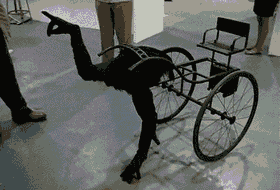Jinny
 |
| Hand Shaped Ostrich Robot at Kinetica 2012 |
The bird-thing image started me thinking about legged robotics again. What is the best way to pull a load anyway, with bird legs (knees hinged towards the back) or with mammal legs (knees hinged towards the front)? Seems like all real-world pack animals have front facing knees, just like humans do. In fact, it is still common in some parts of the world for humans to pull loads around with rickshaws. Hum... robotic legs pulling a rickshaw. How about robotic legs strong enough to pull me around in a rickshaw. Strong legs would need a lot of power; generating power adds more weight. Seems like a portable air compressor in a rideable cart and big leg pistons could be a way to go. So once again, what started out as a modesty sized rational project has morphed into a crazy-big-ass-over-engineered circus. I have bravely cleaned out a 4x8 foot work space in the garage and I'm ready to dive-in. What can I say; this is where my muse is taking me; I can either follow where she leads me or loose my creative way.
Wiki says the word rickshaw originates from the Japanese word jinrikisha, where jin = human, riki = power and sha = vehicle. From the word jin, I am naming this project Jinny. I am committed now.
This is a big project that may take as long as two years to complete. I will break the project up into three parts:
 |
| Cart sketch. |
 |
| Servo follower pneumatic piston. |
Phase three will be writing the arduino uno micro controller program that runs things. This will be the most formidable part of the project, especially since I skipped building a smaller version of the project where I could have developed control loops without accidentally bashing into my wife's parked car. Indeed, the compressor easily produces 100 PSI which could generate over 700 pounds of force at the piston heads. I will have to have several levels of safety built into the design and still be very careful.


great idea bro (y), do make sure you don't have any bugs in your loop of your programs
ReplyDeleteand do have a provision for direct shut down of whole system since in case something goes wrong you can manually shut the system . All the best :)
Thanks for the encouragement.Your note prompted me to get off my butt and make another post. I't's hard to work on this project in the winter.
ReplyDeleteYes, I have to be careful with this thing; I made the pistons a bit too powerful. I have an adjustable safety valve and a manual pressure relief valve, but still run the risk of bending the aluminum piston rods if they try to over extend. I stand way back from the leg end when I pressurize the system. Thanks for the input, Dexter.